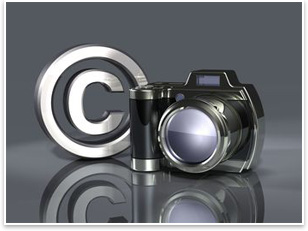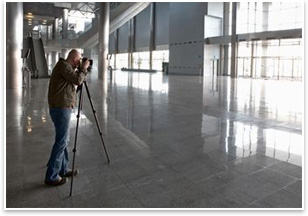Copyright or Copy Wrong?
Fifth in a Series
by Gregory Hancks, AIA
Associate General Counsel
 Summary: You may know (or think you know) your basic rights and obligations under copyright law. But what misconceptions are commonly held by people you work with, your boss or employees, your clients, or your consultants? You might be surprised. Summary: You may know (or think you know) your basic rights and obligations under copyright law. But what misconceptions are commonly held by people you work with, your boss or employees, your clients, or your consultants? You might be surprised.
This is the fifth in a series of articles exploring various aspects of copyright that are frequently misunderstood. In this installment, we consider another type of copyrightable work that architects frequently use: photographs.
Give photos the respect they are due
The previous article discussed the primary categories of architects’ work that warrant protection under the U.S. copyright statute:
- drawings (“technical drawings, including architectural plans”)
- specifications (“literary works”)
- architectural design itself (“architectural works”).
Missing from that initial list is another category of significance to the profession—photographs. Like architectural drawings, photographs are explicitly listed in the copyright statute as being included in the protected category of “pictorial, graphic, and sculptural works.”
Accordingly, federal law grants a copyright in a photo to the person who takes it, regardless of the photo’s quality or subject matter. Unlike drawings, however, photos are not as frequently included in lists of an architect’s “Instruments of Service,” even though a photo taken by an architect to carry out architectural services easily fits within the meaning of that term. Architects who take photos as part of their work for a client nevertheless own a copyright in those photos, unless the written professional services agreement transfers that copyright to the client.
 The omnipresence of photos in our personal and work lives may lead to a false sense that photos, once published or otherwise distributed, are fair game for copying and reuse. This misconception is only reinforced by the Internet, as the first article in this series described. Most of us share an intuitive belief that redistributing someone else’s photos that show identifiable people may violate the rights of the people in the photo (for example, the right of privacy and the right of publicity). Unfortunately, that intuition appears not to extend to the photographer’s own rights in the photo, regardless of whether the photo was taken for personal or professional purposes. The omnipresence of photos in our personal and work lives may lead to a false sense that photos, once published or otherwise distributed, are fair game for copying and reuse. This misconception is only reinforced by the Internet, as the first article in this series described. Most of us share an intuitive belief that redistributing someone else’s photos that show identifiable people may violate the rights of the people in the photo (for example, the right of privacy and the right of publicity). Unfortunately, that intuition appears not to extend to the photographer’s own rights in the photo, regardless of whether the photo was taken for personal or professional purposes.
Possessing a copy of a photo, whether in printed or electronic form, is not the same as owning the copyright in that photo. If you want to reuse or republish a photo that you didn’t take, copyright law means that you need a license or permission from the owner of the copyright.
Giving architectural photographers the respect they are due
Anyone who has tried to photograph a building exterior or interior for professional purposes can’t help but marvel at the skill of those who do it and achieve good results. Many professional architectural photographers are members of the American Society of Media Photographers (ASMP). The AIA has collaborated with ASMP on a best-practices publication titled “Commissioning Architectural Photography,” which describes what should be considered when retaining architectural photography services.
Just as most architects view their work as primarily a service provided
to a client to meet the client’s specific needs, so do architectural
photographers view the work they do as a custom service rather
than a physical product. As a result, architectural photographers
consider their photographs to be akin to an architect’s Instruments
of Service instead of a product that is sold outright. Architects
prefer to retain the copyright in their work, including their Instruments
of Service, and so do architectural photographers.
 It is for this reason that design awards programs run by the AIA typically require only a limited copyright license for the project photos submitted. Generally speaking, the AIA does not require applicants for design awards to grant the AIA an unlimited license (or copyright ownership) in photos submitted with the application. The AIA is therefore usually unable to reuse or republish design awards photos for other purposes without getting an additional permission from the copyright holder. It is for this reason that design awards programs run by the AIA typically require only a limited copyright license for the project photos submitted. Generally speaking, the AIA does not require applicants for design awards to grant the AIA an unlimited license (or copyright ownership) in photos submitted with the application. The AIA is therefore usually unable to reuse or republish design awards photos for other purposes without getting an additional permission from the copyright holder.
This isn’t just about giving the photographer credit, although most photographers want to have a credit line included when their photos are published. It’s about not violating the legal property rights of the copyright owner.
Architecture vs. photos
The relatively recent (1990) extension of copyright protection to architectural works highlighted more distinctions between architecture and other forms of copyrightable work than was described in the prior article. The copyright statute deals directly with some of these issues, such as ensuring that a building owner’s right to alter or demolish it would not be limited by any copyright in the architectural design.
The statute also resolves the logical conflict between protecting a copyrighted architectural design from copying in any media and the long-standing public presumption that anyone is free to take photos of buildings. The statute makes an exception for photographing buildings. In the words of the statute, the fact that a building is a copyrighted architectural work does not “prevent the making, distributing, or public display of pictures, paintings, photographs, or other pictorial representations of the work, if the building in which the work is embodied is located in or ordinarily visible from a public place.”
The person taking the photo of a copyrighted building has a copyright in that photo that is separate from the copyright in the architectural work.
 The
ethics angle The
ethics angle
Some complaints filed with the AIA’s National Ethics Council (NEC) under the Code of Ethics and Professional Conduct contain allegations that involve project photos, including whether appropriate credit is given to project participants. The NEC has also considered whether a firm’s departing partners or employees should have the right, under the AIA’s Code of Ethics, to obtain and use project-related materials. Rules 5.302 and 5.303 deal with the rights of departing staff to copies of such materials.
In a 1988 ethics case, the NEC interpreted and applied the precursor of Rule 5.303, which currently states: “A Member shall not unreasonably withhold permission from a departing employee or partner to take copies of designs, drawings, data, reports, notes, or other materials relating to work performed by the employee or partner that are not confidential.” The NEC’s decision on this issue as it relates to project photos is worth quoting at length:
Photographs are of a different character from any of the other items in the list. The photographs at issue here were not design materials since they were commissioned after the projects were completed. Moreover, the taking of photographs for record and marketing purposes is a well-established part of architectural practice. ... We think that it stretches the language of the rule too far to find that professionally commissioned photographs not taken by the employee himself must be supplied by an employer to his departing employees.
Alongside the NEC’s discussion of the ethical issue, it should be noted that an independent architectural photographer—not the architecture firm—may well own the copyright in project photos commissioned by a firm. In that circumstance, the firm may not have the right to provide copies to departing partners or employees for those individuals’ own separate use. A request for copies of such photos is more appropriately directed to the architectural photographer. |



 The omnipresence of photos in our personal and work lives may lead to a false sense that photos, once published or otherwise distributed, are fair game for copying and reuse. This misconception is only reinforced by the Internet, as the
The omnipresence of photos in our personal and work lives may lead to a false sense that photos, once published or otherwise distributed, are fair game for copying and reuse. This misconception is only reinforced by the Internet, as the  It is for this reason that design awards programs run by the AIA typically require only a limited copyright license for the project photos submitted. Generally speaking, the AIA does not require applicants for design awards to grant the AIA an unlimited license (or copyright ownership) in photos submitted with the application. The AIA is therefore usually unable to reuse or republish design awards photos for other purposes without getting an additional permission from the copyright holder.
It is for this reason that design awards programs run by the AIA typically require only a limited copyright license for the project photos submitted. Generally speaking, the AIA does not require applicants for design awards to grant the AIA an unlimited license (or copyright ownership) in photos submitted with the application. The AIA is therefore usually unable to reuse or republish design awards photos for other purposes without getting an additional permission from the copyright holder. The
ethics angle
The
ethics angle